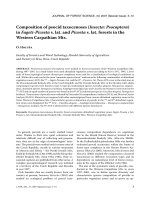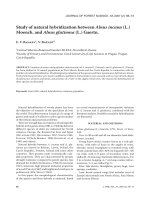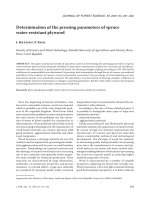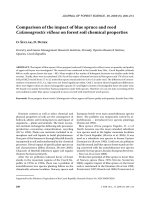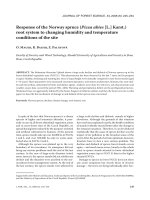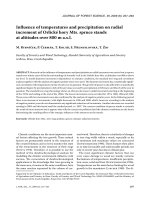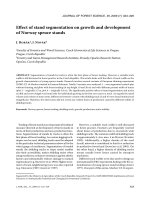Báo cáo lâm nghiệp: "fumigation of Norway spruce at timberline" pdf
Bạn đang xem bản rút gọn của tài liệu. Xem và tải ngay bản đầy đủ của tài liệu tại đây (191.14 KB, 5 trang )
Ozone
fumigation
of
Norway
spruce
at
timberline
W.M.
Havranek
1
G.
Wieser
1
M.
Bodner
2
1
Forstliche
Bundesversuchsanstalt,
Aul3enstelle
fOr
subalpine
Waldforschung,
Innsbruck,
and
2
Institut
fur
Botanik
der
Universitit
Innsbruck,
Austria
Introduction
Ozone
is
thought
to
be
involved
in
forest
decline
(Bucher,
1986;
Krause
et
al.,
1986),
especially
at
high
altitudes,
where
increased
03
levels
together
with
a
fast
increase
in
forest
damage
has
been
observed
(Berichte
Tiroler
Landtag,
1985-1988).
Many
investigations
on
the
impact
of
03
on
trees
have
been
carried
out
under
laboratory
conditions,
mainly
with
seedlings,
but
few
in
the
field
(Smidt,
1978;
Pye,
1988).
Experimental
data
of
effects
of
03
on
adult
trees
under
field
conditions
are
rare
(Coyne
and
Bingham,
1982)
or
lacking
altogether
as
for
instance
for
the
timberline
region.
Therefore
it
seemed
to
be
of
interest
to
fumigate
an
adult
spruce
tree
with
various
03
concen-
trations
and
to
examine
the
effects
of
03
on
gas
exchange
and
chlorophyll
fluores-
cence,
both
known
to
be
indicators
of
latent
or
hidden
03
injury.
Materials
and
Methods
For
this
study,
a
60
yr
old
spruce
tree
(Picea
abies
(L.)
Karst.)
near
the
Klimahaus
research
station
on
Mt.
Patscherkofel
(1920
m
a.s.l.)
near
Innsbruck
was
selected.
For
each
treat-
ment,
6
similar
twigs
were
enclosed
in
plexi-
glass
chambers,
where
the
air
was
exchanged
3-4
times
per
minute.
03
treatments
were
as
follows:
control
(charcoal-filtered
air),
ambient
air,
ambient
air
+
38
ppb
03
(1987)
and
120
ppb
03
(1986),
respectively.
The
twigs
were
left
in
the
fumigation
chambers
for
one
full
growing
season
(July
to
September).
Monthly
means
of
03,
air
temperature,
relative
humidity
and
sums
of
precipitation
for
1986
and
1987
are
given
in
Table
I.
03
was
produced
with
a
UV-lamp
(Osram
HNS-UOZ)
and
03
concentrations
in
the
cham-
bers
were
checked
daily
with
an
ozone
meter
(Monitor
Labs
Mod.
8810).
All
gas
exchange
measurements
were
made
in
ambient
air
with
a
thermoelectrically
controlled
Minicuvette
Sys-
tem
(Walz,
Effeltrich,
FRG).
Measurements
were
taken
at
light
saturation,
leaf
temperatures
of
21°C
(1986)
or
18°C
(1987)
and
at
a
relative
vapor
pressure
deficit
of
10.6
Pa/kPa.
Chlorophyll
fluorescence
of
small
twigs
from
all
cuvettes
(i.e.,
6
replicates
per
treatment)
was
also
measured
in
situ
after
predarkening
with
light
tight
bags
in
1987
(23
September,
during
daylight
hours).
A
pulse-modulation
fluorometer
(Pam
103,
Walz,
Effeltrich,
FRG)
was
used,
as
described
by
Schreiber
et aL
(1986).
Results
and
Discussion
At
the
end
of
the
fumigation
period,
all
twigs
looked
healthy
and
there
was
no
visible
needle
damage.
However,
03
concentrations
were
high
enough
to
alter
gas
exchange
parameters.
Stomatal
conductance
In
no
case
investigated
did
03
treatments
reduce
stomatal
conductance
to
values
lower
than
those
of
control
twigs.
On
the
contrary,
low
doses
of
03
seemed
to
increase
conductance
at
least
temporarily.
In
1986,
a
4
wk
fumigation
with
120
ppb
led
to
a
statistically
significant
increase
of
conductance
of
45%
compared
to
03
-free
controls,
which
disappeared
after
12
wk
of
fumigation
(Table
II).
Under
the
1987
conditions,
all
treatments
resulted
in
simi-
lar
stomatal
conductance.
A
stomatal
behavior
similar
to
that
observed
in
1986
was
found
by
!Celler
and
H5sler
(1984)
in
spruce
seedlings,
where
conductance
was
also
higher
and
stomata
reacted
more
sluggishly
than
in
controls.
Chlorophyll
fluorescence
and
net
photo-
synthesis
After
8
wk
of
fumigation
in
1987,
all
samples
exhibited
normal
fluorescence
transients.
There
were
no
significant
differ-
ences
between
the
quenching
coefficients
(
Fig.
1
The
quotient
(F
max
-
FO
)/
F
max
’
which
is
a
quantitative
measure
of
the
photochemical
efficiency
of
photosystem
II,
was
between
0.81
and
0.82
for
all
3
treatments
which
is
within
the
normal
range
for
C3
plants
(Bj6rkman
and
Dem-
mig, 1987).
At the
same
time,
net
photosynthesis
was
slightly
but
not
significantly
reduced
in
03
-treated
twigs.
12
wk
of
fumigation
with
ambient
air
also
did
not
alter
photosynthe-
sis
significantly
compared
to
controls
(Fig.
2).
Elevated
03
levels,
however,
led
to
a
significant
decline
in
photosynthesis.
Cur-
rent
year’s
needles
fumigated
with
ambient
air
+
38
ppb
03
during
daylight
hours
showed
a
decline
of
10%
and
needles
treated
with
120
ppb
03
contin-
uously
showed
a
decrease
of
30%
when
compared
to
controls.
Last
year’s
needles
had
reduced
photosynthesis
by
about
5%
after
treatment
with
ambient
air
+
38
ppb
03-
In
discussing
our
results,
we
always
have
to
keep
in
mind
that
this
fumigation
experiment
was
performed
with
only
one
tree.
These
results
indicate
that
at
timber-
line,
where
pollutants
other
than
03
were
largely
absent
(Smidt,
1983),
ozone
concentrations
of
the
ambient
air
did
not
alter
gas
exchange
or
chlorophyll
fluores-
cence
significantly
within
one
vegetation
period.
Ozone
concentrations
slightly
higher
than
that
in
ambient
air,
however,
could
stimulate
stomatal
opening
leading
to
higher
ozone
uptake
into
the
needles
and
reducing
their
photosynthetic
rates
in
spite
of
the
higher
stomatal
conductance.
Thus
we
conclude
that
03
concentrations
higher
than
100
ppb
persisting
for
long
time
periods
or
a
general
further
increase
of
03
above
present
ambient
levels
would
reduce
photosynthesis
in
spruce,
which,
in
combination
with
bad
climatic
or
poor
soil
conditions,
might
result
in
a
greater
sus-
ceptibility
to
climatic
and
biotic
damage.
References
Berichte
an
den
Tiroler
Landtag (1985-1988)
Zustand
der
Tiroler
WAider.
Amt
der
Tiroler
Lan-
desregierung,
Landesforstinspektion
Innsbruck
Bj6rkman
O.
&
Demmig
B.
(1987)
Photon
yield
of
02
and
chlorophyll
fluorescence
characteris-
tics
at
77K
among
vascular
plants
of
diverse
origins.
Planta
170,
489-504
Bucher
J.B.
(1986)
Wirkungen
von
ozon
auf
waidbdume.
XVll
th
IUFRO
World
Congr.
Ljubl-
jana
Yugoslavia,
Sept.
1986
Proc.
Div.
2,
Vol.
I,
pp.
306-319
9
Coyne
P.I.
&
Bingham
G.E.
(1982)
Variation
in
photosynthesis
and
stomatal
conductance
in
an
ozone-stressed
ponderosa
pine
stand:
light
re-
sponse.
For.
Sci.
28,
257-273
Keller
T.
&
HAsler
R.
(1984)
The
influence
of
a
fall
fumigation
with
ozone
on
the
stomatal
be-
havior
of
spruce
and
fir.
Oecologia
(Berlin)
64,
284-286
Krause
G.H.M.,
Arndt
U.,
Brandt
C.J.,
Bucher
J.,
Kenk
G.
&
Matzner
E.
(1986)
Forest
decline
in
Europe:
development
and
possible
causes.
Water
Air
Soil
Pollut
31, 647-668
Pye
J.M.
(1988)
Impact
of
ozone
on
the
growth
and
yield
of
trees:
a
review.
J.
Environ.
Qual.
17, 347-360
Schreiber
U.,
Schliwa
U.
&
Bilger
W.
(1986)
Continuous
recording
of
photochemical
and
non-photochemical
chlorophyll
fluorescence
quenching
with
a
new
type
of
modulation
fluoro-
meter.
Photosynth.
Res.
10,
51-62
Smidt
S.
(1978)
Die
wirkung
von
photochemi-
schen
oxydantien
auf
waidbiume.
Z.
Pflanzenkr.
Pflanzenschutz
85,
689-702
Smidt
S.
(1983)
Ober
das
auftreten
von
ozon
und
stickstoffoxiden
in
waldgebieten
Oster-
reichs.
Eur.
J.
For.
Pathol.
13, 133-141
